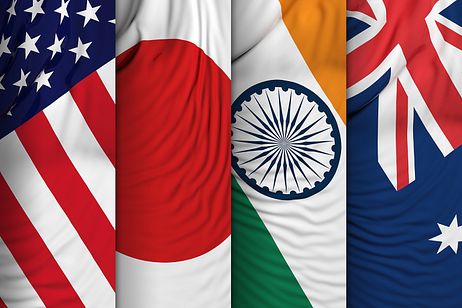The Quad: What It Is – And What It Is Not

The Quad is no Asian NATO. And that may be its greatest strength.
The March 12 summit meeting of the Quadrilateral Security Dialogue or Quad, comprising the United States, India, Japan, and Australia, has not been fully grasped by most analysts. The Quad’s recent resurgence – after an abortive start in 2007 – has been driven by uneasiness about the rise of China and the security threat it poses to the international order. Yet there is no direct reference to China, or even military security, in the Quad’s first-ever joint statement or the Washington Post op-ed penned by its four leaders.
On the contrary, the most significant outcomes of the summit are related to COVID-19 vaccine production, facilitating cooperation over emerging technologies, and mitigating climate change.
This apparent disconnect speaks to the true nature of the Quad. Commentators often cast it as an “alliance” in the making, perhaps an “Asian NATO.” It is not. Rather, the Quad is designed as a loose-knit network of like-minded partners aiming at a broader purpose.
The Quad: Post-summit statements
Post-summit statements, which stressed the humanitarian origins of their collaboration in the aftermath of the 2004 Indian Ocean tsunami, set out the group’s uniting principles – democracy, a rules-based order, and a free, open and inclusive Indo-Pacific – and emphasized its role as a “force for global good.” These provide the broad framework within which the Quad will operate with the aim of shaping global order in an age of transition from the U.S. “unipolar” world to one in which China is seeking a decisive role.
The threat posed by China is at one level military, as evidenced by its proactive pursuit of territorial claims in South Asia, the South China Sea, and the East China Sea. At another, it is economic and technological. China is a pivotal player in global supply chains, most visible today in its major role as a vaccine supplier, a major investor of surplus capital globally through the Belt and Road Initiative, and a rapidly rising technological power.
It is this broader aspect of global order that the Quad aims to address, as is clear from two of the joint statement’s specifics, which focus on the establishment of working groups on vaccine development and critical technologies. Both these efforts seek to constrain China’s central position in the global system, but also to develop a world order that is broad-based and inclusive. The third working group being set up is on climate change, an area in which China is a cooperative player and not a competitor, and thus downplays the notion that the Quad is simply an instrument of containment. Together, the three initiatives are designed to create an environment that encourages China to be a positive player and persuades other states to shed their hesitancy toward the Quad.
The Quad: Focused on Non-Military initiatives
Though the summit focused on non-military initiatives, the Quad by no means downplays the military dimension. Its members have established the basis for regular defense cooperation through naval exercises, and the sharing of intelligence and military logistics. Adding further heft to previous bilateral efforts, the trilateral India-U.S.-Japan Malabar naval exercises expanded to include Australia last year. The four states have consolidated their military responses by building a set of nested strategic partnerships: linking their bilateral relationships with the India-Japan-U.S., India-Australia-Japan, and U.S.-Japan-Australia trilaterals. The Quad is a logical extension of this network and has the potential to build a “Quad Plus” arrangement involving Canada, France (scheduled to join in a five-nation military exercise in April), and perhaps New Zealand and the United Kingdom.
With these arrangements doing the heavy lifting on the security front, the Quad has the bandwidth to focus on countering the challenging non-security frontiers of Beijing’s influence. Addressing the latter, the group has promoted Japan’s Partnership for Quality Infrastructure – rechristened the Expanded Partnership for Quality Infrastructure – and introduced the multi-stakeholder Blue Dot Network process, both intended to create a globally recognized evaluation and certification system for investments in sustainable developmental projects in the Indo-Pacific region.
The Quad: Prioritized restructuring.
The Quad has also prioritized restructuring supply chains to wean them away from Chinese interference. With China leveraging vaccine diplomacy to a large number of recipient states, the four members have decided to test the Resilient Supply Chain Initiative (conceived by the India-Australia-Japan trilateral) through vaccine production with India as their production hub. If the vaccine initiative is to counter China’s vaccine diplomacy and influence, their cooperation over critical technologies is a second non-military action aimed to undercut the potential of China to achieve a dominant role in telecom and biotech (both mentioned in the joint statement) and other strategically significant areas. Attention to climate change as a third area of mobilization underlines the interdependence and “global common interest” aspect of our world and demonstrates that this is ultimately an open-ended effort to alleviate a serious universal problem.
Baca Artikel Menarik
- Resepi Terung Goreng Berlada Sedap
- Cari pasal, Aliff Syukri pukul Ac Miza
- Resepi Kek Marble Lembap
- Uqasha Dan Kamal Sudah Bernikah!
- Resepi Puding Agar Agar Karamel TanpaTelur
- Resepi Rendang Daging Hari Raya
Layari Laman Facebook My KMU NeT





You must be logged in to post a comment.